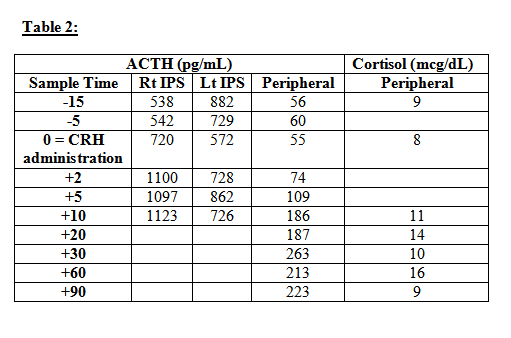
![]() Contributed by Hannah Kastenbaum, MD with Mohamed A. Virji, MD, PhD
Contributed by Hannah Kastenbaum, MD with Mohamed A. Virji, MD, PhD
PATIENT HISTORY:
A 50-year old Caucasian female patient presented for follow up in February 2007, several months after a left tympanomastoidectomy (July 2006) with ongoing complaints of fullness, fluttering, and hearing loss in her left ear. In June 2007, an MRI of the internal auditory canals was performed and incidentally suggested a pituitary mass. A dedicated pituitary MRI was repeated in July 2007 and showed a well-circumscribed 8mm area of less-enhancing tissue within the left pituitary (arrow, Figure 1) without obvious invasion of the cavernous sinuses or impingement on the optic chiasm.
Upon evaluation by endocrinology in August of 2007, the patient noted recent slight weight gain, specifically in her arms, and denied overall significant weight change, proximal muscle weakness, irritability, depression, or cognitive deficits. She had no history or signs of endocrine disease, and had regular cyclic menses. Past medical history was notable only for mild controlled hypertension, on lisinopril and Dyazide, and ongoing ear complaints. Surgical history besides the previous tympanomastoidectomy was noncontributory. Physical exam revealed her to be morbidly obese, with a weight of 240 lb and BMI of 46. She did not exhibit specifically truncal obesity, rounded facies, marked supraclavicular or cervical fat deposition, or purple striae or ecchymoses.
Over the next few months, an extensive laboratory evaluation was performed (Table 1). Random afternoon cortisol, several salivary free cortisols, two 24-hour urine free cortisols, and multiple ACTH determinations showed elevated concentrations. Morning cortisol measurements were repeatedly within normal range. Serum electrolytes and other pituitary hormones were also within normal range. In October 2007, she failed a low dose dexamethasone suppression test (see explanation in "Diagnosis" section).

In November 2007, the patient underwent bilateral inferior petrosal sinus sampling with the following results (Table 2). At baseline time 0, when corticotrophin releasing hormone was administered, there was a right inferior petrosal sinus (IPS) to peripheral ACTH gradient of 13, a left IPS:peripheral gradient of 10.4, and a right to left IPS gradient of 1.3. After 10 minutes, the central to peripheral gradient was > 3.9, and the right to left cross-pituitary gradient was 1.5.

In January 2008, the patient underwent trans-sphenoidal resection of the pituitary lesion. Histology confirmed pituitary adenoma with definitive staining for ACTH (Figure 2).
